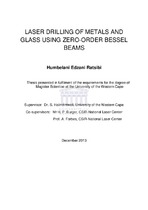Laser drilling of metals and glass using zero-order bessel beams
Abstract
This dissertation consists of two main sections. The first section focuses on generating zero order Bessel beams using axicons. An axicon with an opening angle y = 5⁰ was illuminated with a Gaussian beam of width ω₀ = 1.67 mm from a cw fiber laser with central wavelength λ = 1064 nm to generate zero order Bessel beams with a central spot radius r₀ = 8.3 ± 0.3 μm and propagation distance ½zmax = 20.1 ± 0.5 mm. The central spot size of a Bessel beam changes slightly along the propagation distance. The central spot radius r₀ can be varied by changing the opening angle of the axicon, y, and the wavelength of the beam. The second section focuses on applications of the generated Bessel beams in laser microdrilling. A Ti:Sapphire pulsed femtosecond laser (λ = 775 nm, ω₀ = 2.5 mm, repetition rate kHz, pulse energy mJ, and pulse duration fs) was used to generate the Bessel beams for drilling stainless steel thin sheets of thickness 50 μm and 100 μm and microscopic glass slides 1 mm thick. The central spot radius was r₀ = 15.9 ± 0.3 μm and ½zmax = 65.0 ± 0.5 mm. The effect of the Bessel beam shape on the quality of the holes was analysed and the results were discussed. It was observed that Bessel beams drill holes of better quality on transparent microscopic glass slides than on stainless steel sheet. The holes drilled on stainless steel sheets deviated from being circular on both the top and bottom surface for both thicknesses. However the holes maintained the same shape on both sides of each sample, indicating that the walls are close to being parallel. The holes drilled on the glass slides were circular and their diameters could be measured. The measured diameter (15.4±0.3 μm) of the hole is smaller than the diameter of the central spot (28.2 ± 0.1 μm) of the Bessel beam. Increasing the pulse energy increased the diameter of the drilled hole to a value close to the measured diameter of the central spot.

